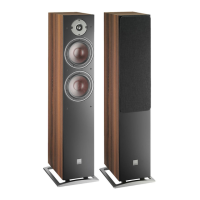UK DE DK CN JP FR
DALI A/S www.dali-speakers.com 9
Lots of pure, undistorted output from a large amplifier is beer than a distorted
signal from a small amplifier stretched beyond its capaci. The signal from a
distorting (clipping) amplifier contains much more high-frequency information
than an undistorted signal, and therefore puts a heavy strain on the tweeter.
Consequently, speakers are oen damaged by small amplifiers, having to work too
hard - and very rarely by large amplifiers, which are practically running idle.
It is worth noting that turning tone controls above the neutral seing significantly
burdens both speakers and amplifier. On a good sound system, tone controls
should only be used to compensate for poor recordings and not to permanently
compensate for weaknesses elsewhere in the system. DALI recommends the
tone controls generally be set to the neutral position, and to achieve your desired
sound image through correct positioning of the speakers. Ensuring that you keep
the volume low enough for the sound to remain clear and undistorted will minimize
the strain on both speakers and amplifier.
All DALI loudspeakers are designed with linear impedance for an optimal amplifier
load. The result is a significantly more open and detailed sonic image.
9.0 THE LISTENING ROOM
Every room has its own distinctive acoustics, which influence the way we
experience sound from a speaker. The sound you hear consists of direct sound
from the speakers and reflected sound from the floor, ceiling and walls. The laer
will aect how you experience the sound.
As a basic rule, try to avoid large, hard and reflective areas in the immediate
vicini of your loudspeakers as it will pically cause strong reflections, which
might disturb the precision and spatial eect of the sound reproduction.
Reflection might be suppressed by positioning e.g. a plant between the speaker
and the reflecting surface. So items such as carpets, curtains etc. might help if
the sound is too bright. Both the amount and quali of the deep bass depend on
the size and shape of the room, and the position of the speakers. Positioning the
speakers near a side or back wall will accentuate the bass.
A corner location will accentuate it even more, but will also increase the reflections.
10.0 TECHNICAL SPECIFICATIONS
In Table 2 you will find the most common specifications for our speakers. Please
have in mind that there are countless methods for measuring speakers. However,
none of them tell you anything useful about how a speaker really sounds. Only
your ears can decide whether one speaker sounds beer than another. Like all
our speakers, DALI OBERON series is designed to reproduce music as honestly
as possible.
Enjoy your new DALI OBERON!

